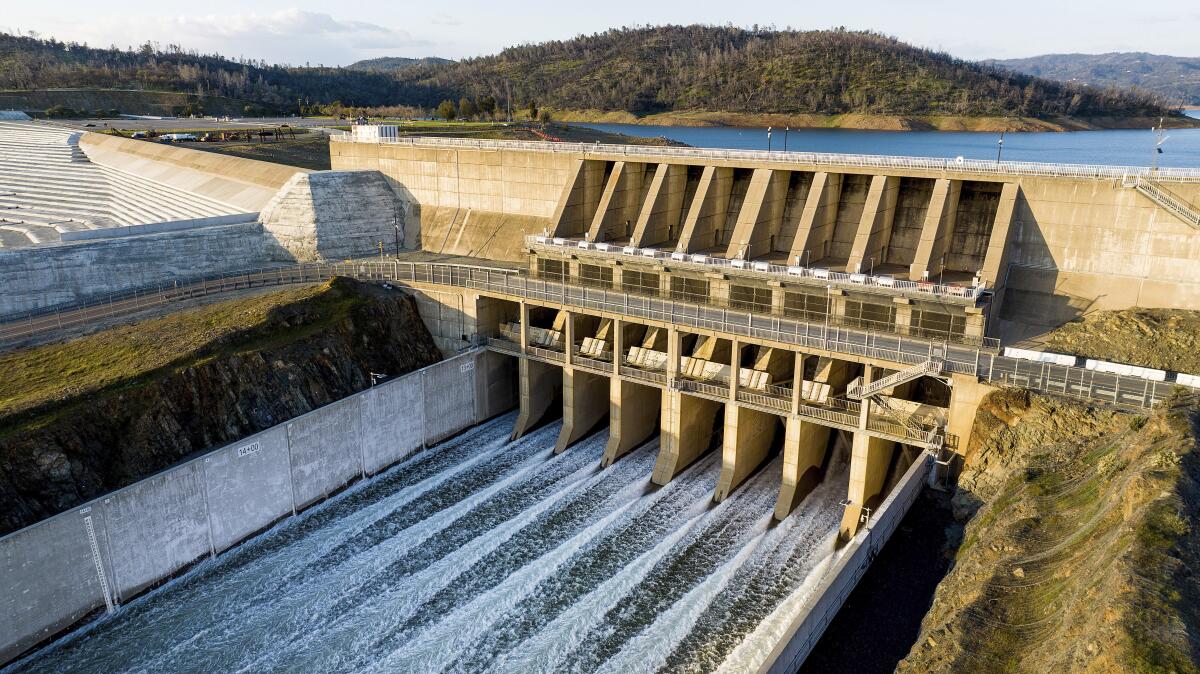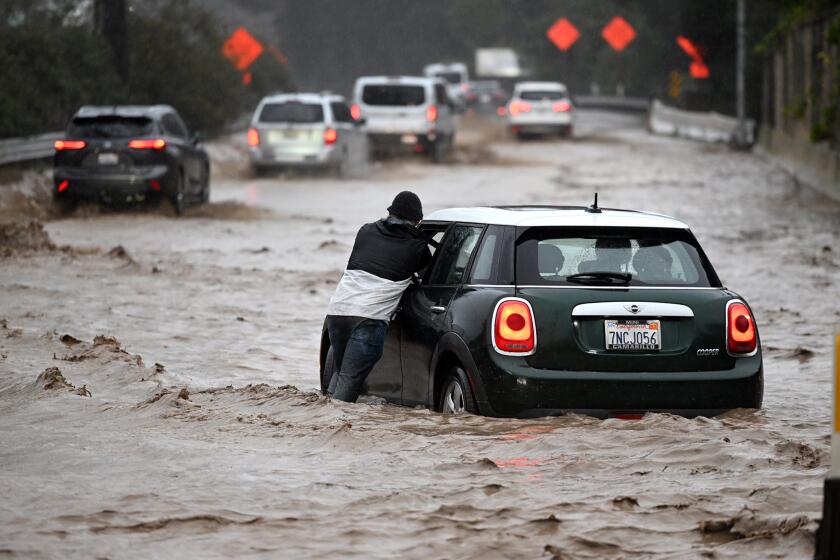California’s blistering heat sparked power shortages last summer. Here’s this year’s forecast

- Share via
Torrential rainfall and massive dumps of snow wreaked havoc across California last winter. But the wild weather brought an upside: Water-storage reservoirs now have abundant supplies of H2O to run the state’s hydropower electricity generators this summer.
That fact, combined with record expansion of utility-scale solar power and battery storage, has energy forecasters confident that the state can avoid the potentially dangerous electricity shortfalls of the sort that came with last September’s 10-day heat wave, according to state officials at a press briefing Wednesday.
The nation’s most populous state normally has more than enough electricity to power the homes and businesses of more than 39 million people. But the electrical grid has trouble when it gets really hot and everyone turns on their air conditioners at the same time.
The state’s electrical grid was strained in part because of a severe drought that kept reservoirs at dangerously low levels, leaving little water available to pass through hydroelectric power plants. The water level in Lake Oroville got so low in 2021 that state officials had to shut down a hydroelectric plant that was capable of powering 80,000 homes.
That won’t be a problem this year after winter storms dumped massive amounts of rain and snow on the state. Plus, an additional 8,594 megawatts of power from wind, solar and battery storage are due to come online by Sept. 1, according to Neil Millar, vice president of transmission planning and infrastructure development for the California Independent System Operator, which runs the state’s power grid.
One megawatt of electricity is enough to power about 750 homes.
Record temperatures. Hot nights. Broiling beaches. Why this California heat wave was so extreme.
“We are better situated than last year. We are cautiously optimistic,” said Siva Gunda, commissioner at the California Energy Commission. State officials noted that the forecasts are based on average temperature ranges, and weather in recent years has been anything but average. “But given the extreme wildness of the climate change, you know we have to be cautious as we move forward, and prepared to support the grid.”
By support the grid, he’s referring to the willingness of California residents last September to cut back on energy usage, particularly during the peak hours between 4 p.m. and 9 p.m. Without the cutbacks, utilities likely would have resorted to power blackouts.
Meteorologists are warning that this year’s El Niño weather pattern could cause especially serious heat waves that could again lead to imbalances in electrical supply in the late summer.
While state officials suggested the wet winter may reduce the risk of wildfire — a source of widespread, long-lasting power blackouts from damaged power lines — in some parts of the state this year, the grass fire activity at lower elevations could still be a wild card. Fire experts also have said that lush, rain-fed grasses and other vegetation will dry over the summer, creating a hazard.
A strong El Niño could augur yet another wet winter for California, as well as drive the global average temperature to a record high, experts say.
Energy officials suggested that Californians sign up for the Flex Alert program, which sends texts or emails with advance warnings of possible power shortages.
And officials with the California Public Utilities Commission said residents can sign up for the Power Saver Rewards program that offers utility bill credit for reducing energy use when a Flex Alert is declared.
The struggle to power the state during severe heat waves has been a problem for Democratic Gov. Gavin Newsom, who has aggressively moved the state away from fossil fuels. California gets much of its power now from sources such as wind and solar. But those power sources are not always available.
To avoid blackouts during heat waves, Newsom and the state Legislature spent $3.3 billion to create a “strategic reliability reserve.” State officials used the money to extend the life of some gas-fired power plants that were scheduled to retire and to purchase large diesel-powered generators. Last September, when a severe heat wave pushed the statewide demand for electricity to an all-time high, this reserve generated up to 1,416 megawatts of energy.
On Thursday, Newsom promoted the state’s updated plan to move the state toward its goal of 100% clean electricity generation by 2045 or sooner. It focuses on the attempt to quicken the transition to renewable sources of energy while assuring reliability and keeping costs as low as possible.
Reforming the permit process, including changes in state environmental regulations, is key to the effort, he said.
“We need to build, we need to get things done. This is not an ideological exercise,” Newsom said during a visit to the Richmond, Calif., headquarters of Moxion Power, located near the Bay Area’s Chevron oil refinery.
The startup company, housed in a building that once assembled the Ford Model T, is manufacturing mobile electric battery storage packs, intended to replace diesel-powered generators. Moxion is receiving rich state support — a matching $15-million taxpayer-financed grant for warehouse construction is pending approval at the California Energy Commission.
Newsom noted that more than 37% of electric power in the state now comes from renewable energy sources, a figure that climbs to 59% when fossil-free hydropower and nuclear power are included.
The Associated Press contributed to this report.
More to Read
Sign up for Essential California
The most important California stories and recommendations in your inbox every morning.
You may occasionally receive promotional content from the Los Angeles Times.
















